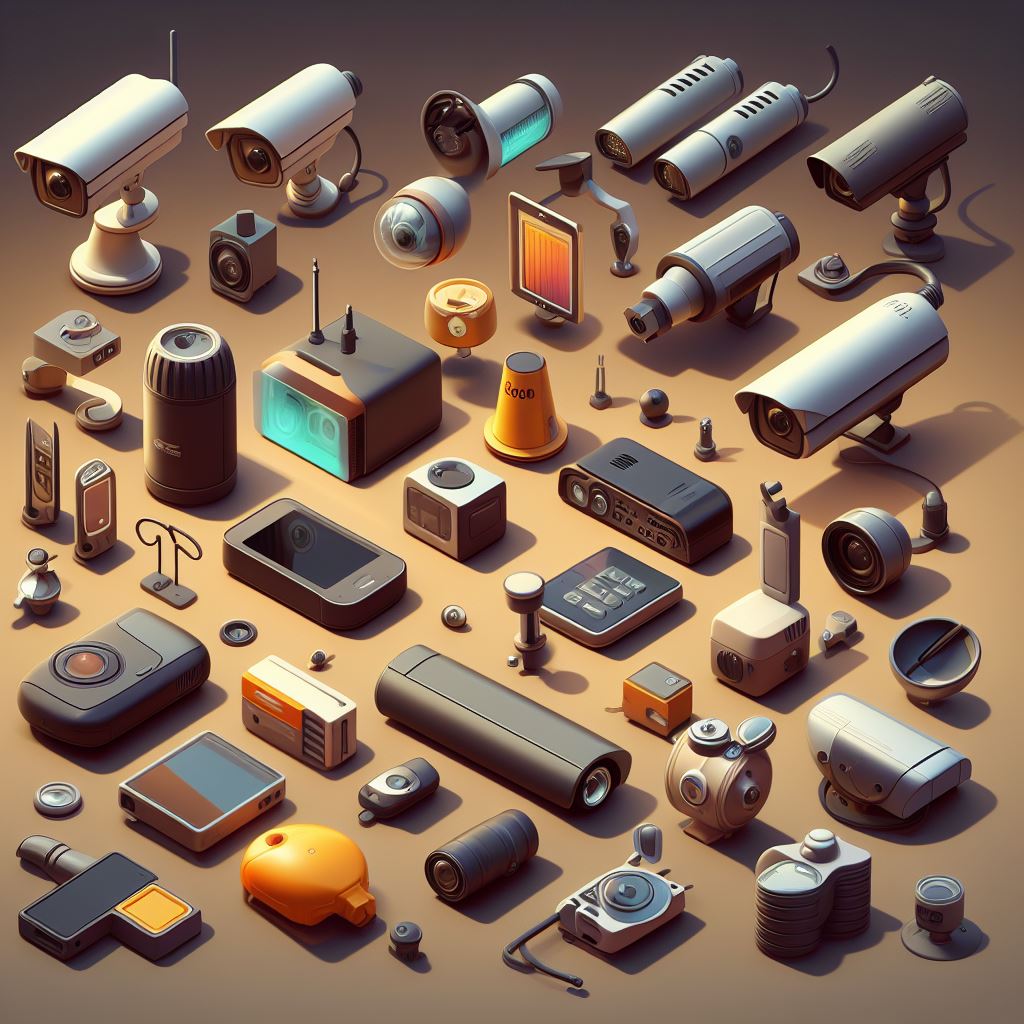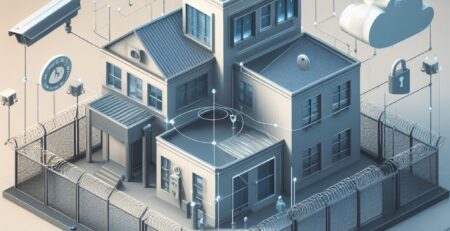Types of surveillance cameras and their applications
Tiago F Santiago2023-11-03T11:26:09-03:00Have you ever wondered what types of surveillance cameras exist and what they are for? Surveillance cameras are devices that capture and transmit images from a specific location for monitoring, security or control purposes. They can be used in different environments, such as homes, businesses, industries, public bodies, among others.
But did you know that there are different types of surveillance cameras, each with its own characteristics, advantages and disadvantages? And that choosing the appropriate type of camera for each situation depends on several factors, such as the objective, the environment, the budget and the available technology?
In this article, we will present some of the main types of surveillance cameras and their applications. We will explain what they are, how they work, what the pros and cons are and in which places and situations they are recommended. This way, you can get a better idea of which type of camera is best suited to your situation. Let's go?
Analog cameras
Analog cameras are the most traditional and simple cameras, which use an electrical signal to transmit images to a recorder or monitor. Images are captured by a light sensor and converted into an analog signal, which is sent over a coaxial or video cable to a storage or viewing device.
Analog cameras have some advantages, such as:
- They are cheaper and easier to install than digital or IP cameras;
- They are compatible with most existing surveillance systems;
- They do not depend on an internet network to function.
On the other hand, analog cameras also have some disadvantages, such as:
- They have low resolution, quality and range of images, which can be distorted or blurred;
- They do not allow remote access, cloud recording or integration with other systems;
- They consume more energy and storage space than digital or IP cameras.
Analog cameras are recommended for places that do not require a lot of clarity or detail in the images, such as parking lots, corridors or outdoor areas. They can be used to monitor the flow of people or vehicles, prevent theft or vandalism or record simple events.
Digital cameras
Digital cameras are cameras that use a digital signal to transmit images to a recorder or monitor. Images are captured by a light sensor and converted into a digital signal, which is sent over a network or video cable to a storage or viewing device.
Digital cameras have some advantages, such as:
- They have high resolution, quality and range of images, which can be enlarged or edited without loss of quality;
- They allow the use of features such as zoom, focus, motion detection, facial recognition, among others;
- They consume less energy and storage space than analog cameras.
On the other hand, digital cameras also have some disadvantages such as:
- They are more expensive and complex to install than analog cameras;
- They are not compatible with some old surveillance systems;
- There may be interference or noise in the transmission signal;
Digital cameras are recommended for places that require more clarity or detail in images, such as stores, banks or indoor areas. They can be used to monitor employee performance, identify customers or suspects, record transactions or evidence, or integrate with alarm or access control systems.
IP cameras
IP cameras are cameras that use the internet to transmit images to a computer or mobile device. Images are captured by a light sensor and converted into a digital signal, which is sent over a wireless or wired network to a server or cloud.
IP cameras have the same advantages as digital cameras, but they also allow:
- Remote access, that is, the possibility of viewing images from anywhere and at any time, through an application or web browser;
- Cloud recording, that is, the possibility of storing images in an online service, without the need for a physical device;
- Integration with other systems, such as sensors, cameras, alarms, among others, through communication protocols.
On the other hand, IP cameras also have some disadvantages such as:
- They are more expensive and complex to install than analogue or digital cameras;
- They depend on a stable and secure internet network to function;
- They may be the target of cyber attacks or invasions of privacy.
IP cameras are recommended for places that require more flexibility, mobility and intelligence, such as homes, offices or public areas. They can be used to monitor the home environment, manage the business remotely, receive real-time alerts or interact with other devices.
Infrared cameras
Infrared cameras are cameras that use infrared radiation to capture images in environments with little or no lighting. Images are captured by a light sensor and converted into a digital signal, which is sent over a network or video cable to a storage or viewing device.
Infrared cameras have some advantages, such as:
- They have the ability to see in the dark, without the need for artificial lighting;
- They can capture images in black and white or color, depending on the type of filter used;
- They are resistant to adverse weather conditions, such as rain, snow or dust.
On the other hand, infrared cameras also have some disadvantages such as:
- They have lower quality than normal cameras, with less contrast and sharpness;
- They may suffer interference or distortion from heat sources, such as bonfires, vehicles or animals;
- They consume more power and generate more heat than normal cameras.
Infrared cameras are recommended for places that require nighttime monitoring, such as warehouses, warehouses or rural areas. They can be used to prevent break-ins, theft or animal attacks, protect property or wildlife or record natural phenomena.
Thermal cameras
Thermal cameras are cameras that use thermal radiation to capture images in foggy, smoky or dusty environments. Images are captured by a heat sensor and converted into a digital signal, which is sent over a network or video cable to a storage or viewing device.
Thermal cameras have some advantages, such as:
- They have the ability to detect the heat of objects, regardless of lighting or visibility;
- They can capture images in false colors, which indicate the temperature of objects;
- They are useful for identifying anomalies, leaks, fires, among others.
On the other hand, thermal cameras also have some disadvantages such as:
- They do not distinguish colors or shapes of objects, only heat;
- They do not allow facial or license plate recognition;
- They are more expensive and complex to install than normal cameras.
Thermal cameras are recommended for locations that require monitoring in adverse conditions, such as ports, airports or industrial areas. They can be used to ensure the safety, quality, efficiency or sustainability of processes, products or services.
Hidden cameras
Hidden cameras are cameras that are disguised or camouflaged in common objects such as watches, pens or glasses. Images are captured by a light sensor and converted into a digital signal, which is sent over a network or video cable to a storage or viewing device.
Hidden cameras have some advantages such as:
- They are discreet and imperceptible, and may go unnoticed by those observed;
- They allow secret monitoring, without the consent or knowledge of those observed;
- They can be portable or fixed, depending on the type of object used.
On the other hand, hidden cameras also have some disadvantages such as:
- They have limited quality, with low resolution and viewing angle;
- They have a reduced autonomy, with low battery or memory life;
- They may be illegal or unethical, depending on the purpose or location of the monitoring.
Hidden cameras are recommended for places that need secret monitoring, such as hotels, meeting rooms or private areas. They can be used to investigate, spy on, catch or report illegal, suspicious or compromising situations.
Conclusion
In this article, we present some of the main types of surveillance cameras and their applications. We have seen that surveillance cameras can be classified as analog, digital, IP, infrared, thermal or hidden, each with its own characteristics, advantages and disadvantages. We also saw that choosing the appropriate type of camera for each situation depends on several factors, such as the objective, environment, budget and available technology.
We hope this article has been useful for you to better understand the types of surveillance cameras and their applications. If you want to know more about this subject, or if you need a personalized solution for your case, we have a special offer for you. Just click on the link below and you will have access to exclusive content and an unmissable discount. Do not miss this opportunity!
Faqs
Here are some unique questions and answers on the topic of the article:
- What is the difference between analog and digital cameras?
Analog cameras use an electrical signal to transmit images, while digital cameras use a digital signal. Digital cameras are of higher quality than analog cameras, but they are also more expensive and complex.
- What is an IP camera?
An IP camera is a camera that uses the internet to transmit images. It allows remote access, cloud recording and integration with other systems. It is more flexible, mobile and intelligent than analog or digital cameras, but it also depends on a stable and secure internet network.
- How do infrared and thermal cameras work?
Infrared and thermal cameras use infrared and thermal radiation to capture images in environments with little or no lighting. Infrared cameras see in the dark, but they are of lower quality than normal cameras. Thermal cameras detect the heat of objects, but they cannot distinguish colors or shapes.
- What are hidden cameras for?
Hidden cameras are used to monitor secretly, without the consent or knowledge of those observed. They are disguised or camouflaged in common objects, such as watches, pens or glasses. They can be used to investigate, spy on, catch or report illegal, suspicious or compromising situations.
- How to choose the right type of camera for each situation?
To choose the right type of camera for each situation, you need to take several factors into account, such as the objective, environment, budget and available technology. It is necessary to evaluate the characteristics, advantages and disadvantages of each type of camera, and compare the options on the market.












Comments (12)
💡 A escolha da câmera de vigilância ideal pode transformar a segurança do seu espaço! Cada tipo tem suas vantagens, então é crucial entender suas aplicações para maximizar a proteção. 🔍
👉 Quer aprofundar seus conhecimentos sobre #Tecnologia e Segurança? Explore mais conteúdos exclusivos em nosso blog na seção #Tecnologia e Segurança.
🤝 Envie um email para nosso departamento comercial! comercial@c2hsolutions.com.br
💡 A escolha da câmera de vigilância certa pode transformar a segurança do seu espaço! Além de proteger, elas oferecem tranquilidade e controle. 👉 Quer aprofundar seus conhecimentos sobre #Tecnologia e Segurança? Explore mais conteúdos exclusivos em nosso blog na seção #Tecnologia e Segurança. 🤝 Envie um email para nosso departamento comercial! comercial@c2hsolutions.com.br
💡 A escolha da câmera de vigilância ideal é crucial para garantir a segurança de qualquer espaço. Cada tipo tem suas particularidades e aplicações que podem fazer toda a diferença!
👉 Quer aprofundar seus conhecimentos sobre #Tecnologia e Segurança? Explore mais conteúdos exclusivos em nosso blog na seção #Tecnologia e Segurança.
🤝 Envie um email para nosso departamento comercial! comercial@c2hsolutions.com.br
🛡️ A escolha da câmera de vigilância ideal pode fazer toda a diferença na segurança do seu espaço. Compreender suas aplicações é essencial para garantir máxima proteção!
👉 Quer aprofundar seus conhecimentos sobre #Tecnologia e Segurança? Explore mais conteúdos exclusivos em nosso blog na seção #Tecnologia e Segurança.
🤝 Envie um email para nosso departamento comercial! comercial@c2hsolutions.com.br
💡 A escolha da câmera de vigilância ideal pode transformar a segurança do seu espaço! Conhecer as diferentes opções e suas aplicações é essencial para garantir a proteção que você precisa.
👉 Quer aprofundar seus conhecimentos sobre #Tecnologia e Segurança? Explore mais conteúdos exclusivos em nosso blog na seção #Tecnologia e Segurança.
🤝 Envie um email para nosso departamento comercial! comercial@c2hsolutions.com.br
💡 A escolha do tipo de câmera de vigilância certa faz toda a diferença na segurança do seu espaço. Conhecer suas aplicações específicas pode otimizar a proteção e a tranquilidade que você busca!
👉 Quer aprofundar seus conhecimentos sobre #Tecnologia e Segurança? Explore mais conteúdos exclusivos em nosso blog na seção #Tecnologia e Segurança.
🤝 Envie um email para nosso departamento comercial! comercial@c2hsolutions.com.br
💡 As câmeras de vigilância são ferramentas essenciais para garantir a segurança em diversos ambientes, cada tipo tem suas particularidades e benefícios. Conhecer suas aplicações pode fazer toda a diferença na proteção do seu patrimônio!
👉 Quer aprofundar seus conhecimentos sobre #Tecnologia e Segurança?
Explore mais conteúdos exclusivos em nosso blog na seção #Tecnologia e Segurança.
🤝 Envie um email para nosso departamento comercial! comercial@c2hsolutions.com.br
💡 A diversidade de câmeras de vigilância é fascinante! Cada tipo oferece uma solução única para diferentes necessidades de segurança, tornando essencial conhecer suas aplicações. 📹
👉 Quer aprofundar seus conhecimentos sobre #Tecnologia e Segurança? Explore mais conteúdos exclusivos em nosso blog na seção #Tecnologia e Segurança.
🤝 Envie um email para nosso departamento comercial! comercial@c2hsolutions.com.br
#Tecnologia e SegurançaTipos de câmeras de vigilância e suas aplicações#Tecnologia e SegurançaSegurança com Inovação e Confiabilidade – C2H Solutions
#Tecnologia e SegurançaTipos de câmeras de vigilância e suas aplicações#Tecnologia e SegurançaSegurança com Inovação e Confiabilidade – C2H Solutions
#Tecnologia e SegurançaTipos de câmeras de vigilância e suas aplicações#Tecnologia e SegurançaSegurança com Inovação e Confiabilidade – C2H Solutions
#Tecnologia e SegurançaTipos de câmeras de vigilância e suas aplicações#Tecnologia e SegurançaSegurança com Inovação e Confiabilidade – C2H Solutions